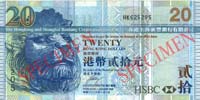Hong Kong dollars
| Hong Kong dollar | |
|---|---|
|
Hong Kong dollar (English) 港元 (traditional Chinese) |
|

|
|
| ISO 4217 | |
| Code | HKD |
| Number | 344 |
| Exponent | 2 |
| Denominations | |
| Subunit | |
| 1⁄10 |
毫 (hou) (Chinese) dime (English) |
| 1⁄100 |
仙 (sin) (Chinese) cent (English) (no longer in circulation) |
| Plural | (no plural) (Chinese) dollars (English) |
| 毫 (hou) (Chinese) dime (English) |
(no plural) (Chinese) |
| 仙 (sin) (Chinese) cent (English) |
(no plural) (Chinese) cents (English) |
| Symbol | $ or HK$ |
| Banknotes | $10, $20, $50, $100, $150, $500, $1,000 |
| Coins | $0.1, $0.2, $0.5, $1, $2, $5, $10 |
| Demographics | |
| Official user(s) |
|
| Unofficial user(s) |
|
| Issuance | |
| Monetary authority | Hong Kong Monetary Authority |
| Website | www |
| Printer |
Issuing banks: |
| Valuation | |
| Inflation | 2.1% |
| Source | [1], Nov 2016 est. |
| Pegged with |
US dollar (USD) $1 USD = HK$7.80 |
| Pegged by |
Macanese pataca (MOP$) HK$1 = MOP$1.03 |
| Hong Kong dollar | |||||||||||||||
| Traditional Chinese | 港元 | ||||||||||||||
|---|---|---|---|---|---|---|---|---|---|---|---|---|---|---|---|
| Simplified Chinese | 港元 | ||||||||||||||
|
|||||||||||||||
| Transcriptions | |
|---|---|
| Standard Mandarin | |
| Hanyu Pinyin | Gǎngyuán |
| Wade–Giles | Kangyüan |
| Yue: Cantonese | |
| Yale Romanization | Gong2yun4 |
| Jyutping | Gong2jyun4 |
Issuing banks:
HSBC
Standard Chartered
Bank of China
Printer:
The Hong Kong dollar (Chinese: 港元; Jyutping: gong2 jyun4; Cantonese Yale: gōng jyun; lit. "Harbour Money"; sign: $, HK$; code: HKD) is the currency of Hong Kong. It is the thirteenth . The Hong Kong dollar is subdivided into 100 cents. It is also used in nearby Macau, where the official currency, the Macau pataca, is of similar value.
In formal Cantonese, the 圓 or 元 (Jyutping: jyun4) character is used. In spoken Cantonese, 蚊 (Jyutping: man1) is used, perhaps a transliteration of the first syllable of “money”, although some suggest that the character comes from the (Jyutping: man4). The dollar is divided into 100 cents, with the character 仙 (Jyutping: sin1, a transliteration of “cent”) used on coins and in spoken Cantonese. However, 仙 is now only used in the stock market, as now it no longer has a note or coin form due to its small value, and is no longer used in regular cash transactions. 分 (pinyin: fēn; Jyutping: fan1) is used in Mandarin. The amount of 10 cents is called 1 houh in Cantonese (毫, Jyutping: hou4, on coins and in spoken Cantonese, 毫子, Jyutping: hou4 zip, in colloquial speech, 角, pinyin: jiǎo; Jyutping: gok3, in Mandarin). The mil was known as the man or tsin in Cantonese (文, pinyin: wén; Jyutping: man4, or 千, pinyin: qiān; Jyutping: cin1, on coins and in spoken Cantonese and Mandarin).
...
Wikipedia
